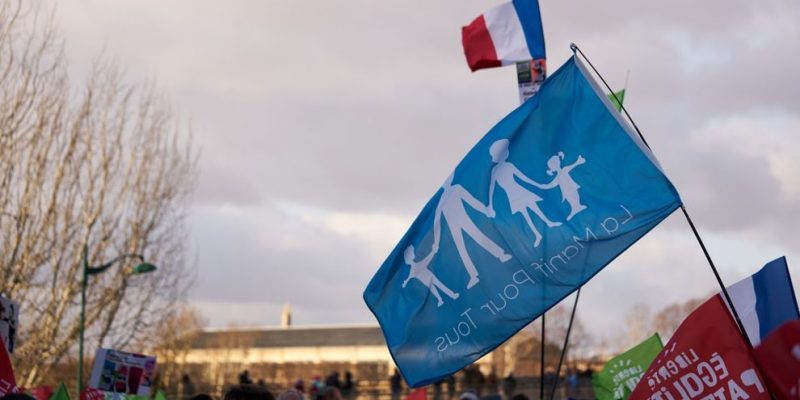We explain what homophobia is, what types exist and its forms throughout history and today. Also, the fight against it.

What is homophobia?
The word homophobia is composed of two Greek words, which are homo“equal”, and phobos“fear”. Currently it is used to give name to the irrational manifestation of fear, aversion or anger towards homosexuality or homosexual people, as long as said feeling has its origin in culture and not in past traumatic experiences.
Although the term lesbophobia exists to refer to the same social phenomenon in relation to homosexual women, the word homophobia usually includes it, as well as the aversion to transsexuality and transsexuals, although the term transphobia was recently coined and is preferred for this purpose. This phenomenon is often anchored in religious, conservative ideas or obsolete and outdated medical discourses.
homophobia It manifests itself in a set of attitudes of contempt and even hatred which can be more or less open and frontal, and more or less violent and dangerous. These attitudes are based on the consideration that homosexuality is an equivocal, morally reprehensible behavior, if not an illness or a psychological problem.
Homophobic or homophobic people may be so without realizing it, or they may have homophobic attitudes without necessarily considering themselves homophobic, or without agreeing with what is described in the previous paragraph, even if they are friends or family members of homosexual people.
It is also possible to find homophobic attitudes in homosexual people, which further aggravates their suffering by adding guilt or self-contempt to the rejection they feel.
The reasons behind homophobia can be very diverse. It is common for it to manifest itself as part of the discourse of groups that are already violent. such as racial supremacism, or from very conservative sectors of society, such as religious fundamentalism.
There are, however, those who see in the attitudes of irrational rejection or obsessive persecution a hidden declaration of interest, so that at the heart of the homophobe there would be a strongly repressed homosexual impulse. There is, in any case, a lot of debate about it.
See also: Discrimination
Types of homophobia
Without there being a single or universal classification, homophobia can be differentiated according to where it comes from:
- Institutional homophobia. That which comes from official institutions, is the product of government decisions or is nested in the discourse or practices of religious, social or cultural institutions.
- Learned homophobia. The one that is transmitted to us culturally and socially without anyone stating it frontally or directly, but rather is fed passively from the established gender roles that society as a whole imposes on new generations. Even homosexual people receive such an education in which their preferences are not represented.
- Internalized homophobia. The one that comes unconsciously from homosexual people themselves and manifests itself despite not being formally assumed, but often quite the opposite. A person can even be openly homosexual, active in the LGBT+ cause, and yet suffer from internalized or unconscious homophobia.
- Homophobia in heterosexuals. The form, perhaps most common and manifest in people of heterosexual orientation, has to do with the feeling of being threatened by the homosexual's desire or by their gender choice. Furthermore, it is understood as an unnatural form of existence, because it cannot procreate, and therefore it is thought that it comes from some trauma, or even from the lack of “normal” sexual relations, which can lead in the case of women. to “corrective” violations.
Homophobia in history

Homosexuality is as old as humanity the same, or perhaps more, since it is common in higher primates and other animals. Furthermore, it was accepted and recognized as a form of love in cultures as important to the West as Greco-Roman. However, homophobia also has a long history in culture.
For example, homosexuality appears condemned in numerous ancient religious texts like the biblical Old Testament. It is thought that this could come from the prohibition of homosexual relations that the Assyrian king Tiglathpileser I (1114-1076 BC) imposed on the Assyrian Kingdom, of which both Judah and Israel, the Jewish kingdoms, were vassals.
In any case, Hebrew tradition reproduced the prohibition. Then Christianity inherited it, interpreting the Sodom and Gomorrah passages in the Bible as an explicit warning against relationships then considered against nature.
In fact, Saint Augustine (354-430) was the first to document the association of anal sex with the “sin of Sodom” or “sodomy,” although the latter term would appear much later, in the Liber Gommorrhianus of the Benedictine monk and ascetic Petrus Damianus (1007-1072).
But long before, in the 6th century AD. c. already the Byzantine emperor Justinian (483-565) and his consort Theodora (500-548) had expressly prohibited “unnatural” acts relying on different political and religious reasons. They promised the penalty of castration and public humiliation (public parade) for the guilty.
The persecution of the so-called “sodomites” in Christian Europe knew no borders. In both Protestant England and inquisitorial Spain they were crimes severely punished. In the first it was called buggy and was punished by hanging by the Buggery Act from 1533, for example. Only with the French Revolution In 1789 the laws that punished homosexuality with death were abolished.
However, In the Modern Age, homosexuality was not yet accepted. Famous people such as Oscar Wilde (1854-1900) went to prison repeatedly in Victorian England.
The governments of the 20th century, heirs of the same tradition, They also punished homosexuality, especially in fascist dictatorships of Spain and Germany, in which homosexuals were shot or locked up in concentration camps.
Other later regimes had similar measures, such as the so-called Argentine National Reorganization Process or even the Chilean Pinochet regime. Even in non-dictatorial countries, such as socialist Germany (German Democratic Republic) or capitalist Germany (Federal German Republic), homosexuality was a crime until 1957 and 1969 respectively.
This panorama began to improve since the 1970s thanks to sexual liberation movements and counterculture in the West. On the other hand, it had a significant setback when the AIDS pandemic became official, considered during the 1980s as a “homosexual disease.”
Something curious to note is that female homosexuality, although frowned upon and punished, was always less problematic for the established order than male homosexuality. This is undoubtedly due to the subaltern role that women have played throughout history, and the little opportunity they left for experimentation and the search for pleasure, considering how young they were selected for marriage.
Homophobia today

Legislation has become more liberal and tolerant of homosexuality in the West, and recent generations have been much more open about accepting and normalizing it. However, it is impossible to say that homophobia has disappeared. In any case, has become an illegal matter, not formally recognized, but often carried out in practice.
Employment discrimination, harassment and violence, or simply the refusal to recognize certain fundamental basic rights, such as same-sex marriage (or civil union, depending on what you call it), are realities that workers must deal with. homosexuals in the West.
At the same time, Homosexuality remains a crime punishable by death in many nations. of the Middle East or Asia Minor, especially those with theocratic or fundamentalist governments.
It is estimated that, in the year 2000, a homosexual person was murdered every two days in the world, due to violent acts of homophobia. According to Amnesty International figures, 70 countries still formally persecute homosexuality and in 8 of them it is condemned to death.
Fight against homophobia

Fortunately, many initiatives aspire to make homophobia visible and thus take the first steps against it. In fact, since 1990 Every May 17, the International Day against Homophobia and Transphobia is celebrated. (IDAHO), to commemorate the removal of homosexuality from the World Health Organization's list of mental illnesses.
In 2008, the French ambassador to the United Nations formally requested that homosexuality be decriminalized worldwide, through a joint resolution that would, however, be non-binding. The resolution was signed by 66 of the member countries, mostly Western, and rejected by countries such as the United States, China, Russia, El Salvador and Islamic-majority nations.
Despite this, In the West, more and more nations are legalizing same-sex marriage. and adoption by same-sex couples, thus taking giant and unprecedented steps in the matter.
Homophobia and machismo
Machismo and homophobia have a lot to do with each other, as evidenced by the fact that homosexual men are traditionally accused of being “effeminate” or of wanting to be “the woman in the relationship.” In fact, it is also traditional to consider the female sex – the “weaker” sex – as passive compared to the activity of the male.
As will be seen, It is a system of valuing people based on their biological sex or sexual orientation which puts the “macho” at the top of everything: the heterosexual male. That is why, to combat sexism and homophobia, it is necessary to combat machismo at the same time.
References
- “Homophobia” on Wikipedia.
- “Homophobia” in the Language Dictionary of the Royal Spanish Academy.
- “Is homophobia a disease?” on BBC World.
- “Homophobia: The Violence of Intolerance” at United Nations (UN).
- “Hating Gays: An Overview of Scientific Studies” on PBS Frontline.
- “Homophobia (psychology and society)” in The Encyclopaedia Britannica.





